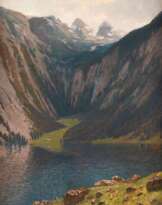Oskar Martin-Amorbach (1897 - 1987)

Oskar Martin-Amorbach
Oskar Martin-Amorbach was a German painter. After completing his studies and getting married, Martin-Amorbach moved to Samerberg in Chiemgau, where he became the youngest member of the artists' association "Die Welle". He became more public through his fresco in the Munich Glass Palace. In 1937 he joined the NSDAP. On July 16, 1939 he was awarded the title of professor in Munich. In 1943 he was appointed professor of history painting at the Berlin Academy of Fine Arts. The style of painting and the selection of motifs in Martin-Amorbach's works were predestined to be appropriated by National Socialist art policy. Rural and rural motifs and depictions of war were themes that were of particular importance for Nazi ideology. The peasant genre, presented in the style of the new objectivity in the wake of Wilhelm Leibl and Franz von Defregger, was intended to depict the peasantry as the "source of blood and life" and the backbone of the "German people's power" and the " national attitude". The images The Sower and The Harvest met these ideological guidelines perfectly. Martin-Amorbach also contributed to the war themes with, among other things, the picture You Drive Death. His popularity in the Third Reich put a strain on his further artistic work after 1945. In 1950 Bishop Julius Döpfner commissioned him to revise and supplement the frescoes in the Neumünster Church in Würzburg, which had been severely damaged by the bombing raid on Würzburg. Martin-Amorbach carried out this work in 1950/51.
| Date and place of birt: | 27 march 1897, Amorbach, Germany |
|---|---|
| Date and place of death: | 11 october 1987, Roßholzen, Germany |
| Nationality: | Germany |
| Period of activity: | XX century |
| Specialization: | Artist, Genre painter, Painter, Portraitist |
| Genre: | Genre art, Nude art, Portrait, Religious genre, Self-portrait |
| Art style: | Realism |
| Technique: | Fresco, Oil, Oil on canvas, Tempera |































